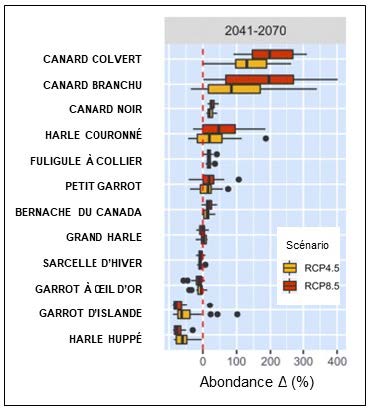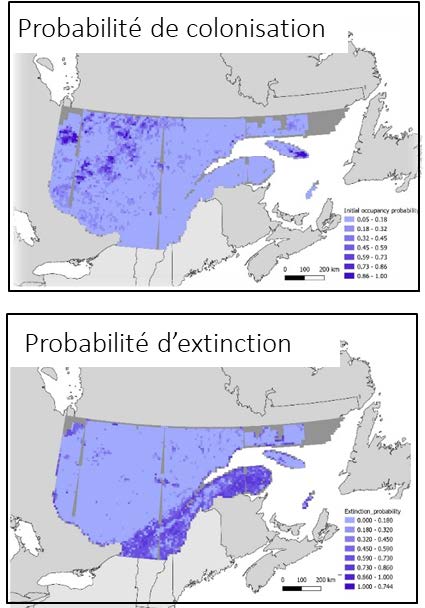Conservation and management of nesting habitats of waterfowl and other waterbirds in the face of climate change
The adaptation strategies proposed upon completion of the project will allow governments and the various organizations concerned to better determine habitats of interest to waterfowl, with regard to land use planning, networks of conservation areas and forestry and agricultural practices.
Project details
Principal(s) investigator(s)

Context
Every year Québec hosts a large proportion of the nesting waterbird population with, for example, more than three million ducks, geese and swans belonging to some forty species; over 50% of the global American black duck population; over 20% of other species, including mergansers and scoters as well as certain subspecies of eiders; and large populations of Canada geese. T
o conserve viable populations of each species, and to maintain certain species above minimum exploitation thresholds to support the ecological services associated with subsistence harvesting and sport hunting, it is essential to identify the habitat areas most suitable for waterfowl in the context of climate change.
Objective(s)
-
Develop tools for adaptation to climate change in eastern Canada to support strategies for the conservation and management of waterfowl and waterbird habitats (sandhill crane, etc.) with a focus on Québec;
-
Maintain the diversity of waterfowl habitats and the ecological services they provide, taking into account the associated socio-economic issues.
Methodology
-
Determine the effects that climate change has had on the distribution and abundance of breeding waterfowl and other waterbirds in eastern Canada;
-
Construct bioclimatic niche models of current distribution and abundance for waterfowl species and predict the effects that climate change will have in the future (2018-2040, 2041-2070 and 2071-2100);
-
Determine potential climate refuges for these species to guide the planning of reproduction habitat conservation in eastern Canada;
-
Develop a co-occurrence model for the American black duck and the mallard to determine mallard encroachment on American black duck habitat under different climate change, forestry management and land-use scenarios, in order to adapt the management of these two species;
-
Determine the factors that explain the presence of sandhill crane in several habitat types and build a predictive model of crane colonisation/extinction in these landscapes to facilitate the adaptation of agricultural practices.
Results
This study was the first major project on waterfowl and climate change in Quebec. It has provided essential information on the current and future distribution of waterfowl during nesting and on emerging issues in their conservation, in terms of both biodiversity and the ecological services and counter-services provided to humans.
The results show that the area between 46-51°N and 70-79°W should be a future hotspot for the conservation of waterfowl diversity by serving as a refuge for both boreal and southern species (Figure 1).

Figure 1.Duck abundance projections.
However, Barrow’s goldeneye, a species that is already at risk in eastern Canada, may disappear as its climatic niche shifts northward, beyond areas of mature forests providing nesting cavities. Sandhill cranes, shown to be nesting in Quebec since 1981, are increasing exponentially in the same zone, where they feed on cereal crops, particularly in Abitibi-Témiscamingue and Lac-Saint-Jean. These cranes do not seem likely to cause crop damage in the St. Lawrence lowlands, at least in the short term.
As for the common eider, the pilot study suggests that with the rise in water level in the St. Lawrence Estuary, the 10 islands hosting the largest colonies (87% of the 45,000 eiders in the estuary) could experience regular full flooding (7 islands) or partial flooding (3 islands) by 2100. Preliminary models of island use suggest where the eiders could move. A draft framework for the socio-economic analysis of potential adaptation solutions has been developed for issues related to waterfowl diversity, the co-occurrence of American black ducks and mallards, and sandhill cranes.
Meetings with project partners made it possible to draw up a list of inputs/attributes for each issue and to perform the initial selection of potential adaptation solutions.
The four components of the study provide tools for adapting waterfowl management in a context of climate change, including:
-
Future hotspots for maintaining waterfowl diversity and priority areas for future conservation (for both advantaged and disadvantaged species) in eastern Canada
-
A preliminary predictive model of the use of nesting islands in the St. Lawrence Estuary for the common eider, the waterfowl species that provides the most ecological services in this area
-
Colonization and extinction models for the sandhill crane in southern Quebec (Figure 2)—omnivorous and opportunistic, it nests in open wetlands and also feeds on cereal plants in agricultural areas, causing crop damage
-
A list of possible adaptation measures for waterfowl management and a framework for their socio-economic assessment

Figure 2. Annual dynamics of the sandhill crane.
Benefits for adaptation
Benefits for adaptation
This study provides essential information on the current and future distribution of waterfowl and on emerging conservation issues. It can be used to identify adaptation solutions that integrate waterfowl conservation issues and socio-economic issues.
Beyond waterfowl, the innovative tools developed in this study (coupling of scientific and citizen science inventories, modelling approaches, identification of potential adaptation solutions and a framework for socio-economic analysis) may be used for other groups of species.
Funding

Other participants
-
Environnement et Changement climatique Canada
-
Ministère de l’Agriculture, des Pêcheries et de l’Alimentation du Québec
-
Ministère de l’Environnement et de la Lutte contre les changements climatiques
-
Ministère des Forêts, de la Faune et des Parcs
-
Hydro-Québec